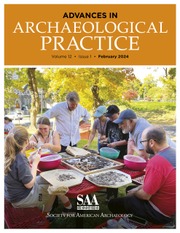Article contents
A Tomb with a View
New Methods for Bridging the Gap Between Land and Sky in Megalithic Archaeology
Published online by Cambridge University Press: 16 January 2017
Abstract
The orientations of European prehistoric structures have been studied independently by landscape archaeologists and archaeoastronomers. Despite their similar interests, the two fields have failed to converge primarily because of their differing epistemologies. This paper argues that archaeology has much to gain by integrating the two fields to provide a fuller and more balanced exploration and understanding of the location and orientation of the European megaliths. It is suggested that prehistoric archaeoastronomy needs to become more grounded on the archaeological record and context of the prehistoric structures it studies. If it is to generate knowledge of value to archaeology it needs to become a “skyscape archaeology.” This paper looks at current archaeoastronomical approaches through the lens of archaeological practice. It identifies some limitations and discusses how landscape archaeology can inform archaeoastronomy on overcoming them. A methodology that attempts this necessary cross-fertilization, by shedding unfounded assumptions and developing a more phenomenological approach to pattern-recognition, is proposed. This methodology is applied to a case study in central Portugal. The emergent narrative, linking a cluster of dolmens to a local mountain range and the star Aldebaran, not only fits the archaeological record, but is mirrored by local folklore, lending further support to the validity of this methodology.
El estudio de las orientaciones de las estructuras prehistóricas europeas se ha llevado a cabo de forma independiente por los arqueólogos del paisaje y por los arqueoastrónomos. A pesar de sus intereses similares, los dos campos no han podido converger, sobre todo, debido a sus diferentes epistemologías. Este trabajo sustenta que, la arqueología tiene mucho que ganar con la integración de los dos campos, al proporcionar una exploración y comprensión más completa y equilibrada de la localización y orientación de los megalitos europeos. La arqueoastronomía prehistórica, como se sugiere, necesita apoyarse más en el registro arqueológico y en el contexto de las estructuras prehistóricas que estudia. Si se trata de generar conocimiento de valor para la arqueología, ésta debe convertirse en una “arqueología del skyscape”. Este trabajo examina los planteamientos de la arqueoastronomía a través de la práctica arqueológica. Este mismo identifica algunas limitaciones y analiza cómo la arqueología de paisaje puede indicar a la arqueoastronomía el cómo superarlas. Una metodología que intenta esta necesaria hibridación, desechando suposiciones infundadas y el desarrollo de una perspectiva más fenomenológica al reconocimiento de patrones, es la propuesta. Esta metodología se aplica a un caso de estudio en el centro de Portugal. La narrativa que surge y que relaciona a un conjunto de dólmenes con una cadena montañosa local y con la Estrella Aldebarán, no sólo se presenta en el registro arqueológico, sino que está reflejada en el folklore local, dándole un mayor apoyo a la validez de esta metodología.
Information
- Type
- Research Article
- Information
- Copyright
- Copyright © Society for American Archaeology 2014
References
References Cited
- 15
- Cited by

